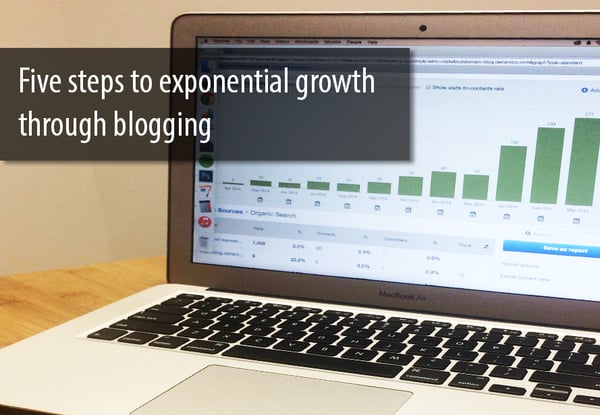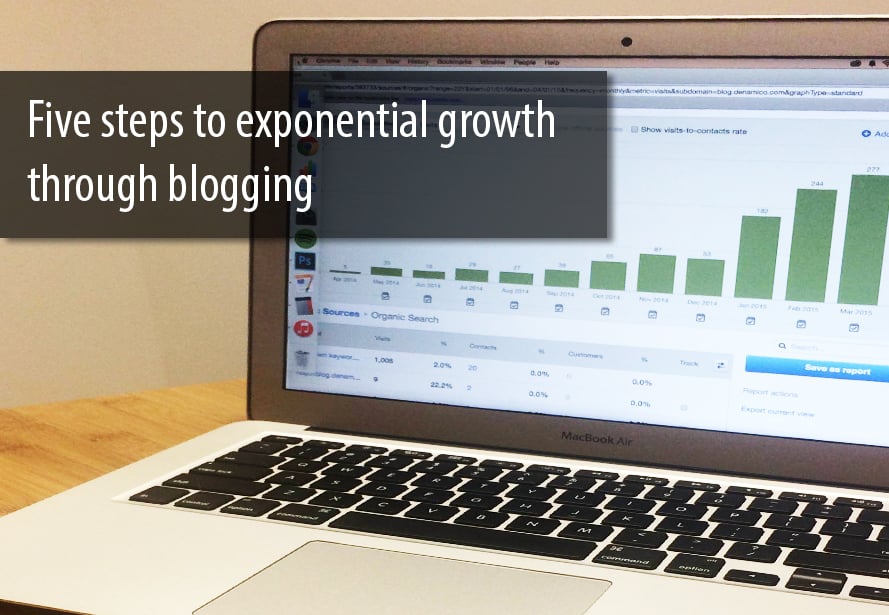How We Tripled Site Traffic in One Year (& How You Can Too...)

In the past year, we have:
- Increased monthly site visits by 284%
- Generated 1040% more leads than we did the same month last year
- Increased organic search presence exponentially (literally)
It also happens that we’re celebrating our one year ‘blog-iversary’ this month. Our company has been around for a few years, but in our first year of consistent blogging, we’ve almost tripled our overall site traffic and are generating many more leads.
Of course, like any marketing team, we still have a lot of work to do. We're always working to understand our audience better so we can create more engaging blog content, increase our reach, and ultimately nurture more leads for sales.
That said, if we weren't sold on the idea of business blogging before, we sure are now.
So for this post, I'd like to share our data-driven approach to blogging in the hopes that you can take some of what we've learned and apply it to your own business blog:
Step 1: Buyer persona research
The #1 mistake most bloggers make when starting out is that they aren’t clear about who they’re writing for.
With so much content out there on the internet, the only way you can attract the right people is to write about topics they truly care about. You should know what keeps them up at night, what they’re passionate about, what they’re insecure about, and where they go to get answers and to be entertained.
There might be several specific groups of people you’d like to target, so make buyer persona profiles for each and prioritize them. This way, when you start developing content, you’ll be targeting the highest-potential group of people.
Early on, we decided to focus our blog on marketing professionals and small to medium business owners who are interested in more efficient ways to market and sell. Though we've been working on ways to be more specific, this focus is what's allowed us to create content that resonates.
Step 2: Research relevant topics & start writing
Once you understand your buyer personas, make a list of long-tail keywords they’re likely to search for.
Next, plug those into a keyword tool like HubSpot’s or Google’s and eliminate the words and phrases with high difficulty scores. Use this list of long-tail keywords to come up with blog topic ideas. This way, your content is most likely to be found via search when your ideal buyer goes looking for answers to their questions.
From a tactical perspective, writing blog content that truly speaks to your buyer personas' interests and contains long-tail keywords can be time-consuming. You may be wondering how many posts to do a week.
We’ve found that two posts per week is sufficient for generating the results we need. When time allows, we write three or four per week.
Any additional posts will improve traffic numbers and expedite your inbound marketing success (as long as you maintain quality in your added posts).
Step 3: Turn blog posts into lead generators
The best way to start generating leads with your blog posts is to create premium content offers and promote them on your blog.
After you've been blogging long enough to see what topics get traction with your audience, you're ready to create content visitors are willing to "pay for" with their contact information.
I recommend starting with a short ebook that expands on your most popular blog posts.
Then, create calls to action (CTAs) that ask blog readers to download your content offer. You’ll need to link to a form on a landing page where readers can request your content and a thank you page where the offer can be accessed. The more closely related your offer is to your blog posts, the more likely people are to click your CTA, fill out your form, and become leads.
Here’s an inbound campaign checklist you can use to make sure you have all the components necessary to make your content campaign a success.
We’ve striven to create at least one monthly content offer that ties to a specific set of blog posts. By making sure that content offer is highly relevant to blog topics, we’ve seen high conversion rates and have been able to generate numerous top-funnel leads.
Step 4: Develop monthly content plan
Once you’ve identified relevant blog topics and developed your first content campaign, the next step is to create organized monthly content plans that will allow you to:
- Vary topics so your content is always fresh
- Streamline your internal process to make content marketing scalable
- Measure, analyze, and adapt tactics to ensure you're always making progress on your goals
Here's how we do ours:
Step 5: Report on results monthly and adapt tactics
When the month is over, we look back on our progress and see how our blog posts and conversion offers measured up to our estimates. If they fell behind, we talk about why and come up with some ways to improve for the next month. If we exceed our goals, we might reexamine them to make sure we’re aiming high enough.
As I mentioned above, the key to our success is measuring progress and adapting our approach based on our analysis of the numbers.
For geeks like us, it’s super exciting to write blog posts and use HubSpot data to reach our goals.
We love it so much, we do it for clients. With that said, if there’s ever anything we can do to help you launch your business blog or optimize it for better lead generation, we’d love to help.

